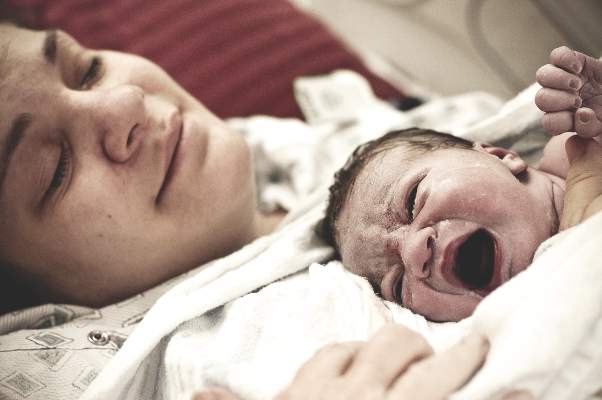User login
The rates of several adverse outcomes appear to be twice as high among planned out-of-hospital births than planned in-hospital births, based on a study in Oregon that relied on more accurate statistical information about planned birth location.
Out-of-hospital births also were associated with fewer obstetrical procedures, and with increased odds of unassisted vaginal delivery.
Nationally, and in most individual states, data for births that were intended to occur in a hospital can not be separated from data for births that were intended to occur at home or at another nonhospital location such as a birth center but required transfer to a hospital. In effect, intrapartum home-to-hospital transfers were inaccurately counted as in-hospital births, said Dr. Jonathan M. Snowden of the departments of ob.gyn. and public health and preventive medicine, Oregon Health and Science University, Portland, and his associates.
In 2012, Oregon began requiring that birth certificates document both the planned place of delivery at the onset of labor and the actual site of delivery. This change allowed researchers to use birth certificate data to assess more accurately maternal and neonatal outcomes by birth plan.
Dr. Snowden and his associates analyzed data from Oregon birth and death certificates during 2012-2013. They focused on 79,727 singleton term deliveries in which 95.2% of the mothers planned to deliver in hospital and did so, 4% planned and completed an out-of-hospital delivery (1,968 at home and 1,235 at a birth center), and 601 women (0.8%) planned an out-of-hospital delivery but ended up delivering in hospital after an intrapartum transfer.
Of mothers who planned an out-of-hospital delivery, 16.5% actually required transfer to a hospital and gave birth there. Misclassifying these births as simply “in-hospital” according to the previous statistical methods “caused rates of adverse outcomes among planned out-of-hospital births to be underestimated (in some cases, substantially),” the investigators said in a study published online Dec. 31 in the New England Journal of Medicine (doi: 10.1056/NEJMsa1501738).
Before intrapartum transfers were classified more accurately, rates of fetal, perinatal, and neonatal death did not differ significantly between in-hospital and out-of-hospital deliveries. After reclassification, death rates were higher for out-of-hospital than for in-hospital births: the fetal death rate was 2.4 vs. 1.2/1,000 deliveries, the perinatal death rate was 3.9 vs. 1.8 deaths/1,000 deliveries, and the neonatal death rate was 1.6 vs. 0.6/1,000 deliveries.
Using the more accurate data, rates of depressed 5-minute Apgar scores, neonatal seizures, and maternal blood transfusions were significantly higher for out-of-hospital than for in-hospital deliveries.
It is important to note that rates of all serious adverse outcomes were very low across the study groups, and that the absolute differences in risk between in-hospital and out-of-hospital delivery were correspondingly small, Dr. Snowden and his associates said.
Alternatively, the odds of NICU admission were lower with planned out-of-hospital births (adjusted odds ratio, 0.71; 95% confidence interval, 0.55-0.92).
Also, planned out-of-hospital birth remained strongly associated with decreased odds of induced labor (adjusted OR, 0.11; 95% CI, 0.09-0.12), cesarean delivery (adjusted OR, 0.18; 95% CI, 0.16-0.22), and other obstetrical procedures, and with increased odds of unassisted vaginal delivery (adjusted OR, 5.63; 95% CI, 4.84-6.55), the researchers wrote.
The rates of several adverse outcomes appear to be twice as high among planned out-of-hospital births than planned in-hospital births, based on a study in Oregon that relied on more accurate statistical information about planned birth location.
Out-of-hospital births also were associated with fewer obstetrical procedures, and with increased odds of unassisted vaginal delivery.
Nationally, and in most individual states, data for births that were intended to occur in a hospital can not be separated from data for births that were intended to occur at home or at another nonhospital location such as a birth center but required transfer to a hospital. In effect, intrapartum home-to-hospital transfers were inaccurately counted as in-hospital births, said Dr. Jonathan M. Snowden of the departments of ob.gyn. and public health and preventive medicine, Oregon Health and Science University, Portland, and his associates.
In 2012, Oregon began requiring that birth certificates document both the planned place of delivery at the onset of labor and the actual site of delivery. This change allowed researchers to use birth certificate data to assess more accurately maternal and neonatal outcomes by birth plan.
Dr. Snowden and his associates analyzed data from Oregon birth and death certificates during 2012-2013. They focused on 79,727 singleton term deliveries in which 95.2% of the mothers planned to deliver in hospital and did so, 4% planned and completed an out-of-hospital delivery (1,968 at home and 1,235 at a birth center), and 601 women (0.8%) planned an out-of-hospital delivery but ended up delivering in hospital after an intrapartum transfer.
Of mothers who planned an out-of-hospital delivery, 16.5% actually required transfer to a hospital and gave birth there. Misclassifying these births as simply “in-hospital” according to the previous statistical methods “caused rates of adverse outcomes among planned out-of-hospital births to be underestimated (in some cases, substantially),” the investigators said in a study published online Dec. 31 in the New England Journal of Medicine (doi: 10.1056/NEJMsa1501738).
Before intrapartum transfers were classified more accurately, rates of fetal, perinatal, and neonatal death did not differ significantly between in-hospital and out-of-hospital deliveries. After reclassification, death rates were higher for out-of-hospital than for in-hospital births: the fetal death rate was 2.4 vs. 1.2/1,000 deliveries, the perinatal death rate was 3.9 vs. 1.8 deaths/1,000 deliveries, and the neonatal death rate was 1.6 vs. 0.6/1,000 deliveries.
Using the more accurate data, rates of depressed 5-minute Apgar scores, neonatal seizures, and maternal blood transfusions were significantly higher for out-of-hospital than for in-hospital deliveries.
It is important to note that rates of all serious adverse outcomes were very low across the study groups, and that the absolute differences in risk between in-hospital and out-of-hospital delivery were correspondingly small, Dr. Snowden and his associates said.
Alternatively, the odds of NICU admission were lower with planned out-of-hospital births (adjusted odds ratio, 0.71; 95% confidence interval, 0.55-0.92).
Also, planned out-of-hospital birth remained strongly associated with decreased odds of induced labor (adjusted OR, 0.11; 95% CI, 0.09-0.12), cesarean delivery (adjusted OR, 0.18; 95% CI, 0.16-0.22), and other obstetrical procedures, and with increased odds of unassisted vaginal delivery (adjusted OR, 5.63; 95% CI, 4.84-6.55), the researchers wrote.
The rates of several adverse outcomes appear to be twice as high among planned out-of-hospital births than planned in-hospital births, based on a study in Oregon that relied on more accurate statistical information about planned birth location.
Out-of-hospital births also were associated with fewer obstetrical procedures, and with increased odds of unassisted vaginal delivery.
Nationally, and in most individual states, data for births that were intended to occur in a hospital can not be separated from data for births that were intended to occur at home or at another nonhospital location such as a birth center but required transfer to a hospital. In effect, intrapartum home-to-hospital transfers were inaccurately counted as in-hospital births, said Dr. Jonathan M. Snowden of the departments of ob.gyn. and public health and preventive medicine, Oregon Health and Science University, Portland, and his associates.
In 2012, Oregon began requiring that birth certificates document both the planned place of delivery at the onset of labor and the actual site of delivery. This change allowed researchers to use birth certificate data to assess more accurately maternal and neonatal outcomes by birth plan.
Dr. Snowden and his associates analyzed data from Oregon birth and death certificates during 2012-2013. They focused on 79,727 singleton term deliveries in which 95.2% of the mothers planned to deliver in hospital and did so, 4% planned and completed an out-of-hospital delivery (1,968 at home and 1,235 at a birth center), and 601 women (0.8%) planned an out-of-hospital delivery but ended up delivering in hospital after an intrapartum transfer.
Of mothers who planned an out-of-hospital delivery, 16.5% actually required transfer to a hospital and gave birth there. Misclassifying these births as simply “in-hospital” according to the previous statistical methods “caused rates of adverse outcomes among planned out-of-hospital births to be underestimated (in some cases, substantially),” the investigators said in a study published online Dec. 31 in the New England Journal of Medicine (doi: 10.1056/NEJMsa1501738).
Before intrapartum transfers were classified more accurately, rates of fetal, perinatal, and neonatal death did not differ significantly between in-hospital and out-of-hospital deliveries. After reclassification, death rates were higher for out-of-hospital than for in-hospital births: the fetal death rate was 2.4 vs. 1.2/1,000 deliveries, the perinatal death rate was 3.9 vs. 1.8 deaths/1,000 deliveries, and the neonatal death rate was 1.6 vs. 0.6/1,000 deliveries.
Using the more accurate data, rates of depressed 5-minute Apgar scores, neonatal seizures, and maternal blood transfusions were significantly higher for out-of-hospital than for in-hospital deliveries.
It is important to note that rates of all serious adverse outcomes were very low across the study groups, and that the absolute differences in risk between in-hospital and out-of-hospital delivery were correspondingly small, Dr. Snowden and his associates said.
Alternatively, the odds of NICU admission were lower with planned out-of-hospital births (adjusted odds ratio, 0.71; 95% confidence interval, 0.55-0.92).
Also, planned out-of-hospital birth remained strongly associated with decreased odds of induced labor (adjusted OR, 0.11; 95% CI, 0.09-0.12), cesarean delivery (adjusted OR, 0.18; 95% CI, 0.16-0.22), and other obstetrical procedures, and with increased odds of unassisted vaginal delivery (adjusted OR, 5.63; 95% CI, 4.84-6.55), the researchers wrote.
FROM THE NEW ENGLAND JOURNAL OF MEDICINE
Key clinical point: More accurate statistical methods show higher rates of several adverse outcomes among planned out-of-hospital births.
Major finding: 16.5% of mothers who planned an out-of-hospital delivery actually required transfer to a hospital and gave birth there, causing substantial underestimation of adverse outcomes for planned out-of-hospital deliveries.
Data source: A population-based retrospective cohort study involving 79,727 singleton term deliveries in Oregon during a 2-year period.
Disclosures: This study was principally supported by the Eunice Kennedy Shriver National Institute of Child Health and Human Development, and also by the Oregon Building Independent Careers in Women’s Health Scholars, the Jonas Doctoral Scholars Program, Sigma Theta Tau Beta Psi, and the American College of Nurse-Midwives.

